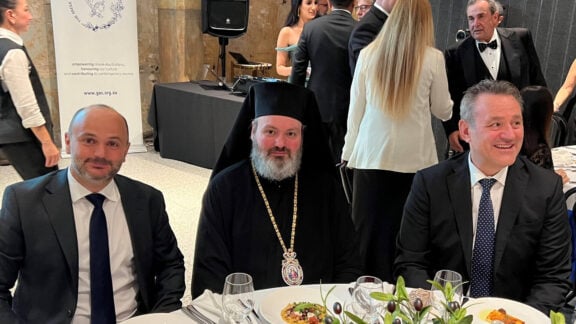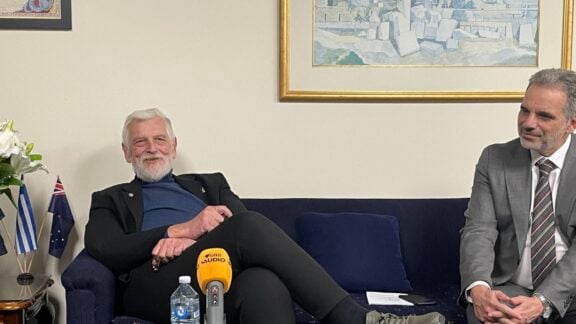Understanding the inner workings of a complex system is vital for finding effective solutions, whether it’s a mechanic repairing an engine, or researchers seeking treatments for neurological disorders like Parkinson’s disease.
Associate Professor Michael Lazarou and his team from Melbourne’s Walter and Eliza Hall Institute (WEHI) have embraced this principle and made a discovery that shows promise in developing new treatments for Parkinson’s disease.
“In order to have any idea about how to fix something, you first need to know how it works. For example, if a mechanic has no idea how an engine works, then they won’t know where to begin to fix it, when it’s broken down. Now we have a good idea of what we can do to try and fix the problem,” says Michael Lazarou to Neos Kosmos.
“The mechanics” of mitochondria
The 41-year-old Greek Cypriot-Australian, dedicated eight years of his work to the study of a vital cellular component known as mitochondria.
“Within every cell of our body, these tiny structures known as mitochondria, play a crucial role in generating the chemical energy that our cells in our body need to survive, including our brain cells. In Parkinson’s disease, these mitochondria break down, leading to a decline in their function, that can ultimately cause the death of brain cells,” he explains.
Lazarou the laboratory head at WEHI, who also holds a co-appointment at Monash University, admits that his interest in studying and “fixing” mitochondria began “a long time ago.”
After completing his PhD, which focused on the role of mitochondria in inborn diseases primarily affecting children, he came across a groundbreaking discovery made by Richard Youle’s lab in the United States.
This research revealed the involvement of Parkinson’s disease-related proteins in a pathway responsible for eliminating damaged mitochondria.
Intrigued by this discovery, Lazarou joined the lab early on.
The significance of this finding was widely acknowledged and recognized, earning the researchers the prestigious Breakthrough Prize in 2021, which carried a value of 2 million US dollars.
Unlocking the potential of key proteins
Lazarou and his team’s research, which was published in the journal Molecular Cell, offers insights into the crucial role of Optineurin; a protein responsible for recognising and targeting dysfunctional mitochondria within the cell.
“Two proteins called PINK1 and Parkin, along with Optineurin, collaborate to identify those mitochondria that have become damaged or dysfunctional, and then get rid of them.
“Optineurin, which is a focus of that study, is a protein that helps connect the signal that PINK1 and Parkin generate and say to the cell ‘ok this mitochondrion is damaged we need to get rid of it.’ Optineurin recognises that and initiates the formation of what we call ‘garbage bags.’ It wraps around the mitochondria and takes it to a part of the cell where it’s broken down and removed,” he explains.
According to Lazarou “in inherited cases of Parkinson’s disease you can have mutations in PINK1 or Parkin, and this leads to a build-up of mitochondria, ultimately resulting in Parkinson’s disease.”
While “most case of Parkinson’s’ are not inherited,” he underscores the importance of studying inherited cases.
“The reason we study the inherited form is that they give us a better understanding of what can go wrong in the disease and what we should target,” he remarks, and adds that “by understanding how Optineurin works, we now have an idea of how to target the protein.”
Following this discovery, Lazarou reveals that the next step is to “take the work into neurons.”
He explains that this process involves “growing neurons using stem cells,” to test the hypothesis within a neuronal environment and “see if it works.”
This approach will facilitate the development of strategies, including drug screens, specifically designed to target Optineurin, and explore its potential applications in the context of medical treatments.
An innate curiosity translated into a specific scientific interest
Lazarou’s fascination for science began to flourish during his primary school years in Melbourne, when a group of individuals visited his school to showcase a series of “cool experiments.”
These scientific demonstrations, resonated deeply with him, fuelling his determination to explore the wonders of science even further.
“That’s when I knew I wanted to become a scientist,” he shares.

As a child, Lazarou admits that he always “liked fixing things.”
This innate curiosity and problem-solving mindset translated into a specific interest in unravelling the complexities of mitochondria as he became captivated by the question of how to address and repair malfunctions within these intricate cellular components.
Fostering strong bonds with Greece and Cyprus
Lazarou’s strong sense of connection to the Greek community was evident in his embrace of his cultural heritage while pursuing his scientific interests.
He attended Greek school St. Nektarios in Fawkner until year 12, enriching his bond with the Greek language and history.
One of his memorable experiences was his involvement with the Mill Park Soccer Club, a Cypriot club in Melbourne, which held tryouts for the Australian Cypriots soccer team.
As a teenager, he vividly remembers participating in these tryouts, eventually leading to a trip to Cyprus where his team competed against the local team.
“We flew to Cyprus and played against the Cypriot team. They were much better than us and they beat us by quite a big score, but it was still fun. We also ended up in a Cypriot soccer show where they interviewed us. That was fun too,” he recalls.
Lazarou further shares his enthusiasm for Greece, and specifically highlights the island of Crete. He describes it as a “hidden gem” and one of his favourite holiday destinations, due to its “beautiful beaches.”
Academia paving the way for new discoveries
Lazarou embarked on his scientific journey through undergraduate studies and an Honours research project in Australia. In 2008, his dedication and hard work paid off when he was awarded his PhD from La Trobe University.
Along the path of his academic pursuit, Lazarou found himself guided and inspired by a lecturer who introduced him to the field of mitochondria.
In 2010, he furthered his research by conducting post-doctoral studies at the National Institutes of Health in the USA, focusing on mitochondrial dysfunction in Parkinson’s disease.
This crucial step in his academic journey allowed him to delve deeper into the intricate mechanisms underlying this neurological disorder.
In 2014-2015, Lazarou returned to Australia and established his own lab Monash University.
He currently holds a position at WEHI (Walter and Eliza Hall Institute) while maintaining his co-appointment with Monash University.
Parkinson’s disease (PD) is a neurodegenerative disorder, affecting approximately 10 million people of the global population.
Although there are treatments and therapies aimed at managing the symptoms and enhancing the quality of life for individuals with Parkinson’s, a cure has yet to be discovered.
As scientists and medical professionals, such as Lazarou, acquire valuable insights, they pave the way for the development of new and more targeted treatments, ultimately, progressing towards a cure.







